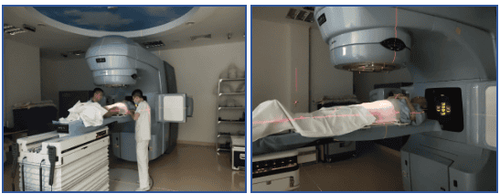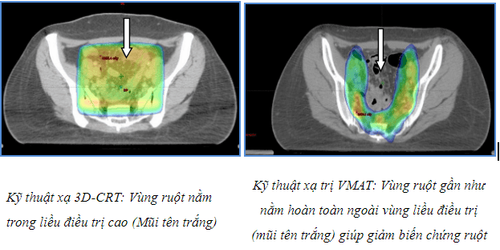This is an automatically translated article.
The article was written by MSc Doan Trung Hiep - Head of Radiation Therapy Department, Technician Nguyen Van Han and Technician Nguyen Van Nam - Radiation Therapy Center - Vinmec Times City International Hospital.Gynecological cancers include malignant tumors of the female genital tract such as in the vulva, vagina, cervix, uterus, fallopian tubes or ovaries. In the United States, according to the American Cancer Society, 105,890 women will be diagnosed with some form of gynecological cancer during the year. Cancers of the uterus and cervix are the most common gynecological cancers treated with radiation and account for 60,050 new cases each year. Extensive gynecological cancer screening with the PAP test allows doctors to detect precancerous changes in the cervix and vagina early.
1. Gynecological cancer treatment
Gynecological cancer treatment depends on several factors, including the type of cancer, the extent (stage) of the cancer, the location of the cancer, and your overall health. These factors are important when talking with oncologists, including radiation oncologists, surgeons, and oncologists, before deciding on the best treatment for you. , with your type of cancer and your daily health care.
Sometimes, only one treatment is used, but in most cases it is necessary to combine multiple treatments such as surgery, chemotherapy and radiation.
2. Radiation therapy for gynecological cancer
Radiation therapy is indicated for relatively safe and effective treatment of gynecological cancers. Radiation oncologists use beams of radiation to kill cancer cells, control cancer cell growth, or relieve symptoms, such as pain.
Radiation therapy damages the inside of cancer cells by destroying their ability to multiply. When these cells die, the body naturally removes them. Healthy cells are also affected by radiation, but they can repair themselves by a self-healing mechanism that cancer cells do not have.
There are two main types of radiation therapy: external radiation therapy (using a system of radiotherapy accelerators to deliver beams of radiation to the tumor site from outside the body) and internal radiation or brachytherapy (using radiation therapy). use a radioactive source to put into the vulva, uterus, cervix or surrounding tissue for a certain time to kill cancer cells).

3. Surgery
Surgery is an important part of the treatment for many tumors and gynecological diseases. A gynecological oncologist is a doctor who specializes in surgical removal and treatment of gynecological cancers.
For cancer of the uterus and cervix, surgery usually involves removing the uterus and cervix (called a hysterectomy). The surgeon may also remove the lymph nodes to check for any remaining cancer cells in the abdomen. For less common tumors such as vulvar or vaginal cancer, surgery is often preferable involving removal of part or all of the vulva and sampling of lymph nodes.
Surgery and radiation therapy can be combined to help reduce the risk of cancer recurrence after surgery, but this treatment strategy varies based on the disease and stage of the disease. In some cases where radiation therapy is the mainstay of treatment, the surgeon will continue monitoring after radiation therapy to control signs of recurrence.
4. Medical treatment
Anti-cancer drugs called chemotherapy drugs have been shown to improve cancer cure rates in some gynecological cancer patients. These drugs are used in many different types of cancer and tend to be used in patients with stage II, III, and IV gynecological cancers.
Treatment dosage and treatment schedule are different, and chemotherapy can be given alone or in combination with radiation therapy. Because chemotherapy recommendations differ significantly depending on the disease and stage of the disease, your internist will talk to you about this treatment.
4.1 External radiation therapy
External radiation therapy is usually an outpatient course with precise fractionation of radiation therapy to the tumor. This treatment is non-invasive and painless. Each course of treatment usually lasts for a few weeks continuously from Monday to Friday.


Before starting treatment, you will be scheduled for a CT simulation to provide the radiation therapist with an image of the location of the tumor that can combine both MRI or PET-CT images to help the doctor can clearly define the treatment area.
After the simulation CT scan is over, you will be given a tattoo ink by the radiation therapist to mark small spots on your skin to determine your exact position during the treatment.
Usually, radiation therapy is done with high-energy X-rays, also known as photon rays. Another type of external radiation is proton beam radiation therapy (PBT), which can reduce the dose of radiation to the surrounding healthy muscles around the tumor. Currently, Proton radiation therapy is not available in Southeast Asia.

There are many different radiotherapy techniques that can be used to treat:
Three-dimensional compatible radiotherapy (3D-CRT) is the use of a combination of multiple fixed projection fields that are similar in shape to the shape the tumor to deliver a dose of radiation to the exact tumor site. Arc volume-modulated radiotherapy (VMAT) is a technological advancement in tumor dose delivery. The variation of beam intensity allows precise dose distribution to each organ tissue within the treatment area. Vinmec Times City is the first unit in Vietnam to implement this technique since the end of 2014, for gynecological cancer VMAT helps to reduce unnecessary radiation dose to the small intestine, colorectal, bladder, pelvis and femoral head (reduces the risk of osteoporosis, fractures after radiotherapy...) Your radiologist will discuss with you which radiotherapy technique is best for you.
4.2 Brachytherapy (internal irradiation)
In some cases, the radiologist uses a source of radiation that is inserted and placed inside your body or as close to the tumor as possible. That's called brachytherapy.
For gynecological cancer, this radiotherapy technique is often a very important part of treatment and it is often used. Another name for this type of treatment is implantation of a radioactive source in a tissue or in a cavity. And can be done alone or in combination with external radiation therapy.
Usually, the radioactive source is placed inside the body for a short time and then removed. Your oncologist will discuss your treatment in detail with you. High-dose brachytherapy (HDR) usually does not require hospitalization. A course of treatment is usually 3-6 treatments and 1-2 times per week. Low-dose radiation therapy (LDR) is a single and continuous course of treatment lasting from 48 to 72 hours. You will be hospitalized for this treatment, and it is rarely used. Currently, except for vulvar cancer using radioactive needles belonging to the LDR group, all vaginal and cervical cancers are using HDR.

5. Side effects
Side effects are often different and vary from person to person. Some patients feel comfortable during treatment while others may experience side effects.
Before treatment, ask your doctor about possible side effects of treatment so you can be better prepared for treatment.
Mild fatigue may occur. However, radiation fatigue may improve and recover within a few weeks after radiation therapy ends. External radiation therapy can cause skin irritation. Always keep the skin clean in the treatment area regularly with neutral soap and warm water, wash gently on the skin. Change in bowel habits is one of the common side effects. Some cases of radiation sensitivity may experience symptoms of increased intestinal motility, frequent bowel movements, nausea and bloating. Urinary disorders: frequent urination, painful urination, frequent urination... Risk of infertility may occur after radiation therapy to the pelvic region. So tell your doctor about your fertility plan before treatment so he can give you the right advice. Affecting sexual activity, radiation therapy often causes a decrease in desire and interest in sex. Ask your doctor or nurse about these changes and how to manage these side effects. Certain medications, vaginal dilators, and moisturizers can help ease the side effects of radiation. Pelvic rehabilitation, a type of physical therapy, can also assist you in managing late side effects on sexual or urinary performance.

6. Care in treatment
It is important in the treatment of gynecological cancer to take care of yourself during radiation therapy. The organs around the tumor will also be affected by the radiation dose and they need time and nutritional support to recover such as a balanced diet, adequate mineral supplements, exercise. Light exercise and exercise, as well as giving your body time to rest and recover.
Please follow your doctor's orders. If you are unsure about anything, consult your doctor or nurse. Tell your doctor or nurse about any medications and supplements you are taking. used to ensure your safety during your treatment. Skin care: avoid rubbing the skin of the perineum, wear loose underwear, during treatment, the patient should wear soft paper underwear, avoid direct sunlight on the skin, avoid too hot or cold and do not use wound washes or ointments without consulting your doctor. Bladder care: drink enough water to make sure the bladder is full during radiation, avoid eating spicy, hot foods that increase bladder irritation... Gastrointestinal care: eat easily digestible foods, eat Lots of soft fiber, drink enough water, exercise regularly to avoid constipation, clean bowel movements before radiation therapy every day. Care of the urinary tract: drink a lot of alkaline water: filtered water, corn silk... Urinary side effects are rare at Vinmec Times City Radiotherapy Center, less than 10% are mild. Care of the vaginal area, sexual activities: during and after radiation therapy will cause vaginal dryness and tightness, so additional lubricants, vaginal dilators, and therapeutic exercises will be required. Whether. During radiation therapy, do not have sex. After radiation therapy, surgery, doctors will advise you on a new lifestyle, you need to ask the doctor about this before you leave the hospital.

Completing treatment and recovery can be challenging. Ask for help from friends and family during treatment or if you have any problems, ask for advice and support from the nurses or doctors caring for you.
Vinmec International General Hospital is one of the hospitals that not only ensures professional quality with a team of leading medical doctors, modern equipment and technology, but also stands out for its examination and consultation services. comprehensive and professional medical consultation and treatment; civilized, polite, safe and sterile medical examination and treatment space. Customers when choosing to perform tests here can be completely assured of the accuracy of test results.
Please dial HOTLINE for more information or register for an appointment HERE. Download MyVinmec app to make appointments faster and to manage your bookings easily.














